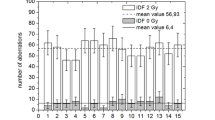Summary
Cultured leukocytes of peripheral blood obtained from normal, healthy individuals and from patients with familial polyposis coli (FP) were exposed to 0 rads or 300 rads of 137Cs gamma radiation at G o to compare damage in these two groups. Only cells in the first mitotic division were considered. The average chromosomal damage in the FP patients was not significantly higher than that in the normal group. The induced chromosomal damage at G o was normally distributed in both the control and the patient groups as well as when they were combined.
Similar content being viewed by others
References
Bodmer WF, Bailey CJ, Bodmer J, Bussey HJR, Ellis A, Gorman P, Lucibello FC, Murday VA, Rider SH, Scambler P, Sheer D, Solomon E, Spurr NK (1987) Localization of the gene for familial adenomatomous polyposis on chromosome 5. Nature 328:614–616
Cherry LM, Hsu TC (1983) Bleomycin-induced chromosome damage in lymphocytes of medullary thyroid carcinoma patients and their family members Anticancer Res 3:367–372
Delhanty JDA, Davis MB, Wood J (1983) Chromosome instability in lymphocytes fibroblasts and colon epithelial cells from patients with familial polyposis coli. Cancer Genet Cytogenet 8:27–50
Domoradzki J, Pegg AE, Dolan ME, Maher VM, McCormic JI (1984) Correlation between O 6-methylguanine-DNA-methyltransferase activity and resistance of human cells to the cytoxic and mutagenic effect of N-methyl-N′-nitrosoguanidine. Carcinogenesis 5:1641–1647
Fineman RM, Morgan M, Burt RW, Gardner EJ (1984) Failure to demonstrate a chromosome 2 deletion in adenomatous colorectal polyposis patients. Cancer 53:317–318
Gardner EJ, Rogers SW, Woodwards S (1982) Numerical and structural chromosome aberrations in cultured lymphocytes and cutaneous fibroblasts of patients with multiple adenomas of the colorectum. Cancer 49:1413–1419
Herrera L, Kakati S, Gibas L, Pietrzak E, Sandberg AA (1986) Gardner syndrome in a man with an interstitial deletion of 5q. Am J Med Genet 25:473–476
Hsu TC, Pathak S, Samaan N, Hickey RC (1984) Chromosome instability in patients with medullary carcinoma of the thyroid. J Am Med Assoc 246:2046–2048
Kakati S, Barcos M, Sandberg AA (1980) Chromosomes and causation of human cancer and leukemia, XLI. Cytogenetic experience with non-Hodgkin, non-Burkitt lymphoma. Cancer Genet Cytogenet 2:199–220
Kasukawa T, Watanabe T, Endo A (1983) Absence of chromosome No 2 homologues in patients with hereditary adenomatosis of the colon and rectum. Cancer Genet Cytogenet 8:283–285
Kinsella TJ, Little JB, Nove J, Weicheslbaum RR, Li FP, Meyer RJ, Marchetto DJ, Bradford PW (1982) Heterogenous response to x-ray and ultraviolet irradiation of cultured skin fibroblasts in two families with Gardner syndrome. J Natl Cancer Inst 68:697–701
Kopelovich L (1982) Hereditary adenomatosis of the colon and rectum: Relevance to cancer promotion and cancer control in humans. Cancer Genet Cytogenet 5:333–351
Kopelovich L (1983) Skin fibroblasts from humans predisposed to colon cancer are not abnormally sensitive to DNA damaging agents. Cell Biol Int Rep 7:369–375
Kopelovich L, Deleo (1986) Elevated levels of p53 antigen in cultured skin fibroblasts from patients with hereditary adenocarcinoma of the colon and rectum and its relevance to oncogenic mechanisms. J Natl Cancer Inst 77:1241–1244
Kopelovich L, Gardner EJ (1983) The use of a tumor promotor for detection of individuals with Gardner syndrome. Cancer 51:716–720
Kopelovich L, Rich R (1986) Enhanced radiotolerance to ionizing radiation is correlated with increased cancer proneness of cultured fibroblasts from precursor states in neurofibromatosis patients. Cancer Genet Cytogenet 22:203–210
Lehman AR (1982) Xeroderma pigmentosum, Coekayne syndrome and ataxiatelangiectasia disorders relating DNA repair to carcinogenesis. Cancer Survey 1:93–118
Little JB, Nove J, Weicheslbaum RR (1980) Abnormal sensitivity of diploid skin fibroblasts from a family with Gardner's syndrome to the lethal effects of x-irradiation, ultraviolet light and mitomycin-C. Mutat Res 70:241–250
Lynch HT, Krush AJ, Thomas RJ, Lynch J (1976) Cancer family syndrome. In: HT Lynch (ed) Cancer genetics. Charles C. Thomas, Springfield, Illinois, pp 355–387
Nielson KB, Bulow S, Tommerup n (1985) Chromosome studies in familial polyposis coli. Cancer Genet Cytogenet 17:355–357
Perry P, Wolff S (1974) New Giemsa method for the differential staining of sister chromatids. Nature 251:156–158
Pfeffer L, Lipkin M, Stulman O, Kopelovich L (1976) Growth abnormalities of cultured human skin fibroblasts derived from individuals with hereditary adenomatosis of the colon and rectum. J Cell Physiol 89:29–38
Rider SH, Mazzullo HA, Davis MB, Delhanly JDA (1986) Familial polyposis coli: growth characteristics of karyotypically variable cultured fibroblasts, response to epidermal growth factor and tumor promoter, 12-O-tetradecanoyl phorbol-13-acetate. J Med Genet 23:131–144
Sandberg AA (1980) Chromosome breakage syndromes. In: The chromosomes in human cancer and leukemia. Elsevier/North-Holland, New York, pp 152–170
Solomon E, Voss R, Hall V, Bodmer WF, Jass JR, Jeffreys AJ, Lucibello FC, Patel I, Rider SH (1987) Chromosome 5 allele loss in human colorectal carcinoma. Nature 328:616–619
Author information
Authors and Affiliations
Rights and permissions
About this article
Cite this article
Kakati, S., Herrera, L., Drury, R.E. et al. Comparison of radiation-induced chromosomal damage between normal individuals and patients with familial polyposis colis. J Cancer Res Clin Oncol 114, 297–300 (1988). https://doi.org/10.1007/BF00405837
Received:
Accepted:
Issue Date:
DOI: https://doi.org/10.1007/BF00405837



